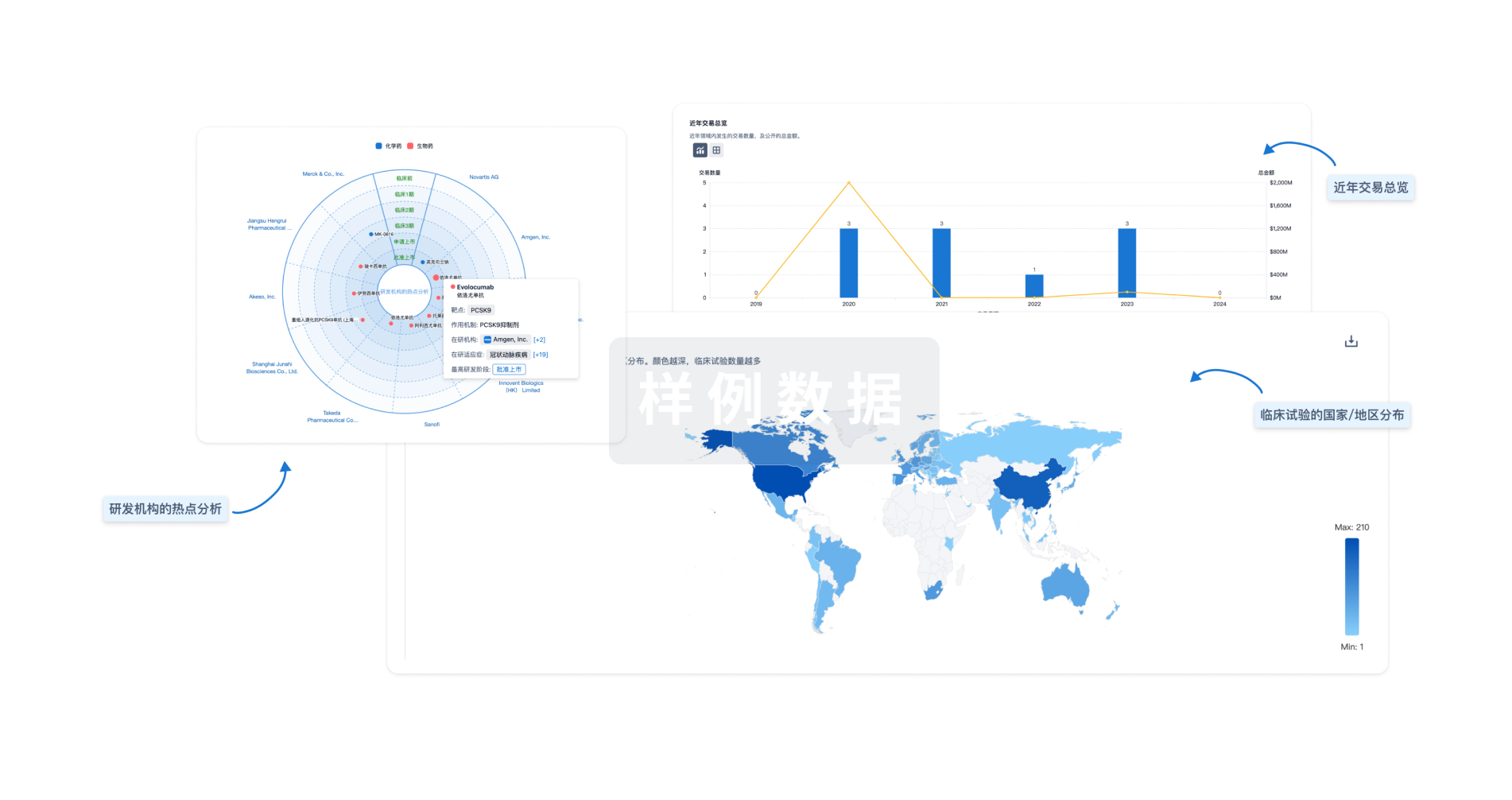预约演示
更新于:2025-05-07
SFRP4
更新于:2025-05-07
基本信息
别名 Frizzled protein, human endometrium、FRP-4、frpHE + [5] |
简介 Soluble frizzled-related proteins (sFRPS) function as modulators of Wnt signaling through direct interaction with Wnts. They have a role in regulating cell growth and differentiation in specific cell types (By similarity). SFRP4 plays a role in bone morphogenesis. May also act as a regulator of adult uterine morphology and function. May also increase apoptosis during ovulation possibly through modulation of FZ1/FZ4/WNT4 signaling (By similarity). Has phosphaturic effects by specifically inhibiting sodium-dependent phosphate uptake (PubMed:12952927). |
关联
1
项与 SFRP4 相关的药物靶点 |
作用机制 SFRP4 modulators |
在研机构- |
在研适应症- |
非在研适应症 |
最高研发阶段无进展 |
首次获批国家/地区- |
首次获批日期1800-01-20 |
100 项与 SFRP4 相关的临床结果
登录后查看更多信息
100 项与 SFRP4 相关的转化医学
登录后查看更多信息
0 项与 SFRP4 相关的专利(医药)
登录后查看更多信息
568
项与 SFRP4 相关的文献(医药)2025-05-01·Biochemical and Biophysical Research Communications
Effect of resveratrol and quercetin on SFRP4 as a biomarker of diabesity: In silico and in vivo studies
Article
作者: Rehman, Asim ; Bukhari, Shazia Anwer ; Noreen, Razia ; Chauhdary, Zunera ; Akhter, Naheed
2025-04-04·Medicine
Screening and identification analysis of core markers for leukemia and cervical cancer: Calmodulin 3 as a core target
Article
作者: Zhu, Xiaoqing ; Shao, Danfeng ; Yu, Huaiying
2025-03-01·Biochimica et Biophysica Acta (BBA) - Molecular Cell Research
A novel function of the Wnt antagonist secreted frizzled-related protein 4 as a transcriptional regulator of Dickkopf-1, another Wnt antagonist, in glioblastoma cell line U87MG
Article
作者: Warrier, Sudha ; Dharmarajan, Arun ; Yasmin, Ishmat Ara
3
项与 SFRP4 相关的新闻(医药)2025-01-06
·生物探索
引言
肥胖与2型糖尿病(Type 2 Diabetes, T2D)已成为全球范围内的重要公共健康问题。2020年,全球约有9.88亿人受到肥胖困扰,而这一数字预计将在2035年翻倍至近20亿。肥胖不仅显著增加心血管疾病、代谢紊乱及多种慢性疾病的风险,还严重影响个人生活质量和寿命。尽管饮食控制、行为干预和代谢手术等方法为肥胖管理提供了多种选择,但如何实现更加持久和高效的体重管理仍然是医学研究的难点和重点。
在这一背景下,药物疗法的快速发展为肥胖和相关疾病的治疗带来了新的希望。其中,司美格鲁肽(Semaglutide)作为一种长效胰高血糖素样肽-1(GLP-1)受体激动剂,凭借显著的降血糖和体重管理效果,成为目前全球范围内备受关注的药物之一。然而,关于司美格鲁肽对人体蛋白质组(proteome)带来的系统性影响,尤其是其在体重降低之外的潜在作用机制,目前尚缺乏深入研究。
1月3日,Nature Medicine的研究报道“Proteomic changes upon treatment with semaglutide in individuals with obesity”,首次采用大规模蛋白质组分析技术,对两项随机、双盲、安慰剂对照的3期临床试验(STEP 1和STEP 2)的血清样本进行了深入研究。研究人员通过使用SomaScan®技术,检测了超过6,400种独特蛋白的相对丰度,揭示了司美格鲁肽在体重调节、糖代谢、脂质代谢以及炎症通路等多方面的作用机制,并探讨了其潜在的心血管保护作用和药物重定位(drug repurposing)机会。
这项研究不仅为深入理解司美格鲁肽的药理机制提供了重要依据,还展示了蛋白质组学技术在疾病机制研究及药物开发中的巨大潜力。
肥胖的全球挑战
肥胖,曾被视为少数人群的健康问题,如今已成为威胁全球公共卫生的“隐形流行病”。根据世界肥胖联合会的数据,2020年全球约有9.88亿成年人和儿童面临肥胖困扰,这一数字预计将在2035年增至近20亿。这一令人震惊的增长速度不仅使肥胖问题成为现代社会的核心健康挑战,也为医疗系统和全球经济带来了空前的压力。
肥胖不仅仅是体重的增加,它与多种疾病密切相关,如2型糖尿病、心血管疾病、高血压以及某些类型的癌症。研究显示,肥胖是导致多重疾病(multimorbidity)的关键因素,严重影响患者的生活质量和寿命。更令人担忧的是,肥胖与心理健康问题之间的关联正变得愈发显著,如抑郁症和焦虑症。对于社会而言,肥胖不仅带来了巨大的医疗开支,还削弱了劳动力生产力,加剧了经济负担。
随着肥胖人口的激增,全球医疗体系正面临巨大的挑战。现有的治疗方法,包括饮食调整、行为干预和外科手术,虽然在一定程度上有效,但往往难以达到长期且显著的效果。而肥胖患者的生理、心理和社会复杂性使得统一的治疗方案难以奏效,这进一步突显了创新疗法的迫切性。
从体重管理到蛋白质组学:突破肥胖治疗的新视角
肥胖的治疗一直是医学界的一大难题。传统的干预方法主要集中在饮食调整、运动疗法、行为干预和代谢手术等方面,虽然这些方法在某些情况下有效,但往往难以实现长期的体重控制。例如,节食虽然可以在短期内显著减重,但随之而来的代谢适应却容易导致体重反弹。类似地,代谢手术虽可显著改善肥胖相关的代谢紊乱,但其高昂的成本和潜在并发症使得推广应用受限。此外,不同个体对同一种治疗方案的反应差异巨大,这种“千人千面”的治疗效果让传统手段显得力不从心。
面对这些局限性,研究人员逐渐将目光投向了肥胖的分子机制,试图从根源上找到更具针对性的解决方案。在这一过程中,蛋白质组学(Proteomics)为肥胖的研究带来了全新的视角。蛋白质组学是一种研究蛋白质结构和功能的高通量技术,能够捕捉体内蛋白质的动态变化,揭示疾病发生、发展的潜在机制。肥胖作为一种复杂的代谢性疾病,其发生不仅涉及能量代谢的失衡,还伴随着广泛的分子水平变化,如炎症、脂质代谢紊乱等。通过蛋白质组学技术,研究人员可以深入探究这些变化,找到疾病发生的“分子信号”。
研究显示,肥胖治疗中的蛋白质组变化不仅反映了体重减轻的直接效应,还揭示了治疗药物在调控其他代谢和炎症通路上的潜在作用。该研究利用SomaScan®技术分析了数千种蛋白质的相对丰度变化,帮助研究人员发现了司美格鲁肽对肥胖相关病理机制的多层次影响。
司美格鲁肽(Semaglutide):不仅仅是减重药物
司美格鲁肽(Semaglutide),作为一种长效胰高血糖素样肽-1(GLP-1)受体激动剂,以其显著的药理作用在糖尿病和肥胖管理中引发了广泛关注。GLP-1是一种由肠道分泌的激素,在调节血糖和食欲中起着关键作用。司美格鲁肽通过模拟GLP-1的作用,在多方面展现了其治疗潜力。
首先,在糖尿病管理中,司美格鲁肽能够显著降低血糖水平。这种作用得益于其刺激胰岛β细胞分泌胰岛素,同时抑制胰高血糖素的分泌。此外,它还延缓胃排空,从而稳定餐后血糖波动。研究表明,在多项大型临床试验中,司美格鲁肽能够有效降低糖化血红蛋白(HbA1c)水平,使患者的血糖控制达到甚至超过目标值。
更引人注目的是,司美格鲁肽在体重管理中的应用。它通过作用于中枢神经系统,抑制食欲,增强饱腹感,同时减少进食欲望。在STEP 1和STEP 2试验中,研究人员观察到,使用司美格鲁肽的患者平均体重显著下降,其中超过一半的受试者实现了至少15%的体重减轻,而这一效果远超其他药物或传统干预手段。此外,司美格鲁肽对肥胖相关的代谢紊乱也有积极影响,包括改善脂质代谢、降低炎症水平等。
然而,司美格鲁肽的作用远不止于减重和降糖。蛋白质组学研究显示,它能够调控多种与心血管疾病、脂质代谢及炎症反应相关的蛋白质。这表明司美格鲁肽可能具有更广泛的治疗潜力,例如降低心血管疾病风险和改善慢性炎症状态。
司美格鲁肽与安慰剂对血液循环蛋白质组的影响(Credit: Nature Medicine)
a,b. STEP 1和STEP 2中蛋白水平的变化效应
STEP 1(a):研究观察到,在使用司美格鲁肽后,有495个蛋白靶点发生了显著变化。这些蛋白的效应量(effect sizes)和统计显著性通过线性回归计算,并经过Holm-Bonferroni多重检验校正。这些显著变化的蛋白与代谢调控、炎症通路以及体重管理密切相关。
STEP 2(b):在STEP 2试验中,共有277个蛋白靶点表现出显著变化。虽然总体数量少于STEP 1,但其发现的变化同样重要,进一步支持了司美格鲁肽的代谢和炎症调控作用。
c. STEP 1和STEP 2的效应量比较
图中显示了两项试验中蛋白效应量的比较(STEP 1与STEP 2)。总体而言,两个试验结果具有较高的一致性,这表明司美格鲁肽在不同人群中对蛋白质组的影响具有可重复性。
虽然如此,部分蛋白在STEP 1中显著,但在STEP 2中未表现出显著变化,这可能与STEP 2样本量较小有关。
d,e. 调整体重和HbA1c影响后的蛋白效应量
STEP 1(d):调整了体重和糖化血红蛋白(HbA1c)的变化后,研究仍发现47个蛋白靶点具有显著变化,提示这些蛋白的调控可能独立于体重和血糖的改善。
STEP 2(e):类似地,在STEP 2中有15个蛋白靶点在调整后仍表现出显著变化,进一步证明司美格鲁肽具有超越体重和血糖调控的作用机制。
突破蛋白质组的密码:STEP 1和STEP 2研究的核心发现
为了深入探究司美格鲁肽在肥胖及相关疾病治疗中的潜在分子机制,研究人员开展了两项大规模随机、双盲、安慰剂对照的3期临床试验——STEP 1和STEP 2。这两项研究结合了蛋白质组学技术,为肥胖和代谢性疾病的治疗带来了前所未有的新发现。
STEP 1研究纳入了1,311名无糖尿病的超重或肥胖参与者,而STEP 2则招募了645名合并2型糖尿病的肥胖患者。研究分别使用了司美格鲁肽2.4毫克的每周皮下注射治疗方案,并通过SomaScan®技术对参与者的血清样本进行蛋白质组分析。这项高通量技术可以同时检测约6,400种独特蛋白的相对丰度,揭示蛋白质层面的动态变化。两项研究的最终样本分别为1,133例(STEP 1)和595例(STEP 2),为确保数据的可靠性,所有样本均经过严格的质量控制和筛选。
研究设计巧妙地通过比较治疗前后的蛋白质组变化,不仅评估了司美格鲁肽在体重调节中的效果,还揭示了其在调控代谢通路和炎症机制中的更深层次影响。例如,在STEP 1中,495个蛋白靶点发生了显著变化,而在STEP 2中,这一数字为277个。这些蛋白中许多与肥胖、糖尿病及其并发症的发病机制密切相关,包括C反应蛋白(CRP)、瘦素(Leptin)、胰岛素样生长因子结合蛋白(IGFBP)等关键分子。
研究还表明,司美格鲁肽的作用不仅仅通过体重减轻和血糖降低实现。在调整体重和HbA1c的影响后,仍有多个蛋白靶点显示出显著变化,表明司美格鲁肽可能通过其他独立途径影响肥胖相关的病理生理过程。
司美格鲁肽的“多维”作用机制
蛋白质组的显著变化:减重背后的分子奥秘
肥胖的治疗不仅关乎体重数字的减少,更关乎复杂的分子调控过程。在STEP 1和STEP 2研究中,司美格鲁肽治疗引发了大量蛋白质组的显著变化,这些变化为揭示减重背后的分子机制提供了重要线索。研究发现,在经过68周的治疗后,STEP 1组中有495个蛋白靶点(涉及438种独特蛋白)发生了显著变化,而STEP 2组中有277个蛋白靶点(涉及244种独特蛋白)表现出显著差异。这些蛋白主要与能量代谢、食欲调节、脂肪分解以及细胞通讯等核心生物过程相关。
其中,瘦素(Leptin)和胰岛素样生长因子结合蛋白(IGFBP)的显著下降反映了体脂减少的直接效果。而神经细胞黏附分子1(NCAM1)和网线受体(UNC5D)的变化则提示,司美格鲁肽可能通过神经和激素途径调节食欲与能量代谢。此外,一些与炎症反应相关的蛋白,如C反应蛋白(CRP)的下降,进一步说明司美格鲁肽在改善肥胖病理机制方面具有多维效应。
糖代谢与脂质代谢的协同调控
肥胖与代谢紊乱之间的关系复杂而紧密。司美格鲁肽不仅在体重管理中发挥了重要作用,还通过调控糖代谢和脂质代谢展现了显著的治疗效果。研究显示,司美格鲁肽能够降低血糖水平,部分原因在于它促进了胰岛素分泌并抑制胰高血糖素的分泌。此外,它对葡萄糖转运蛋白和脂肪酸代谢酶的调节作用,也增强了组织对葡萄糖的利用效率。
在脂质代谢方面,司美格鲁肽显著降低了一些与动脉粥样硬化相关的蛋白水平,例如脂肪酸结合蛋白(FABP)和补体成分C1q受体(CD93)。这种变化不仅有助于减少脂质积聚,还可能降低心血管疾病的发病风险。此外,研究中观察到的脂肪酶(Lipase)和胰酶(Amylase)的水平升高,提示了司美格鲁肽可能通过增强消化酶的分泌来进一步优化脂质代谢。
炎症通路的关键改善
肥胖通常伴随着慢性低度炎症,这不仅加剧了代谢紊乱,还显著增加了心血管疾病的风险。在STEP 1和STEP 2研究中,司美格鲁肽表现出显著的抗炎作用。研究发现,司美格鲁肽治疗后,多种炎症相关蛋白的水平显著下降,包括补体成分和基质蛋白(如TNC和THBS2)。这些蛋白的下调可能有助于减轻心血管系统的压力,同时改善肥胖相关的慢性炎症状态。
此外,司美格鲁肽通过调控免疫细胞功能和炎症因子表达,进一步支持了其抗炎效果。例如,分泌型卷曲相关蛋白4(sFRP4)的降低提示,它可能通过调节脂肪组织的炎症反应来改善胰岛素敏感性。值得注意的是,这些抗炎效应不仅仅依赖于体重减轻,而是司美格鲁肽直接调控炎症通路的结果。
更多的可能性:司美格鲁肽与心血管保护
心血管疾病(CVD)是肥胖和糖尿病患者的主要健康威胁之一,而司美格鲁肽的心血管保护作用成为本次研究的重要亮点。在STEP 1和STEP 2研究中,蛋白质组分析揭示了多种与心血管疾病相关的蛋白水平显著下降,这表明司美格鲁肽不仅仅是一个减重药物,更可能在降低心血管疾病风险方面发挥关键作用。
研究发现,司美格鲁肽治疗显著下调了多个心血管疾病相关的蛋白,包括N-末端B型钠尿肽前体(NT-proBNP)、血管生成素-2(ANGPT2)、补体成分C1q受体(CD93)和基质细胞衍生因子-1(SDF-1)。这些蛋白的异常升高通常与心血管系统的应激反应、血管重塑和炎症密切相关。司美格鲁肽通过降低这些蛋白的水平,可能减轻了心脏负担并改善了血管功能。此外,研究还显示,与体重减轻无关的蛋白变化进一步强调了司美格鲁肽在直接调控心血管健康中的作用。
基于SomaScan®技术的CVD风险评估显示,司美格鲁肽在降低心血管疾病二级风险(如新发心血管事件)方面表现出显著效果。在STEP 1试验中,接受司美格鲁肽治疗的患者,其CVD风险评分显著低于安慰剂组。而在STEP 2试验中,无论司美格鲁肽的剂量是1.0毫克还是2.4毫克,心血管保护效果都显著,这一发现进一步证实了司美格鲁肽的多维作用。
司美格鲁肽的心血管保护作用不仅仅局限于肥胖和糖尿病患者。在SELECT试验的结果中,它同样表现出在无糖尿病但伴有心血管高风险个体中的潜在益处。结合蛋白质组学数据,司美格鲁肽对心血管疾病风险的降低机制可能涉及炎症抑制、脂质代谢改善以及血管功能的全面调控。
该研究的发现为司美格鲁肽在肥胖治疗之外的应用开辟了新的可能性,特别是在心血管疾病预防和治疗领域。
蛋白质组学如何推动药物重定位(Drug Repurposing)?
药物重定位(Drug Repurposing)是指将已批准药物用于新的适应症,这种策略能够大幅缩短研发时间,降低研发成本。STEP 1和STEP 2研究中的蛋白质组学数据为司美格鲁肽的潜在药物重定位提供了重要线索,特别是在治疗与肥胖相关的非代谢性疾病方面展现了新的可能性。
通过SomaScan®的深入分析,研究人员发现司美格鲁肽对一系列与多种疾病相关的蛋白质表达产生显著影响。例如,在STEP 1试验中,纤维肌痛(Fibromyalgia)、抑郁症(Depression)和神经性疼痛(Neuropathic Pain)相关的蛋白发生了显著变化。研究发现,司美格鲁肽能够下调这些疾病中常见的炎症标志物和代谢异常蛋白,这提示其可能通过调控慢性炎症和神经通路,对这些疾病的治疗产生积极作用。
此外,司美格鲁肽对精神类疾病相关蛋白的调控也令人关注。例如,在STEP 1的蛋白质组分析中,涉及抑郁症的某些蛋白显著变化,包括神经元功能相关的关键分子。这种变化可能与司美格鲁肽调节中枢神经系统的机制有关,为其在精神疾病治疗中的潜力提供了科学依据。
更广泛地看,研究还揭示司美格鲁肽可能在治疗其他慢性疾病中发挥作用,如骨关节炎、牛皮癣和某些类型的癌症。司美格鲁肽通过降低与这些疾病相关的蛋白表达,可能减轻炎症反应并改善细胞功能。例如,研究显示其显著调控了与牛皮癣和关节炎相关的免疫通路蛋白,为未来治疗这些炎性疾病提供了新方向。
蛋白质组学的应用使得这些疾病治疗的可能性得以呈现,展示了司美格鲁肽超越肥胖和糖尿病治疗的潜在价值。这不仅扩展了其应用领域,也为精准医学和个性化治疗提供了重要启示,为药物重定位开辟了新的途径。
未来的治疗前景与个人化医学的启示
STEP 1和STEP 2研究的成果不仅揭示了司美格鲁肽在肥胖及相关疾病治疗中的多维作用,还为未来治疗策略的优化和个性化医学的发展提供了宝贵的线索。这些发现强调了精准医学在解决复杂代谢疾病中的潜力。
研究表明,肥胖并不是单一问题,而是与代谢紊乱、慢性炎症、心理健康等多个方面相互交织的复杂疾病。司美格鲁肽通过蛋白质组的多层次调控,超越了传统治疗方法的局限,展现了基于分子机制治疗肥胖的新方向。然而,不同患者对药物的反应存在显著差异,这凸显了个性化治疗的重要性。例如,蛋白质组分析揭示了某些特定蛋白的变化与患者的体重减轻效果密切相关,这为未来通过生物标志物筛选高反应患者提供了可能性。
此外,这项研究的数据还强调了将蛋白质组学与临床实践结合的潜力。例如,动态监测蛋白质组的变化可以帮助医生实时评估治疗效果,甚至预测疾病风险。这种基于分子层面的实时调整将为个性化治疗铺平道路,同时降低过度治疗或治疗无效的风险。
从更广阔的视角看,司美格鲁肽研究展示了肥胖治疗的未来图景:一种以患者为中心的综合管理策略。通过将药物疗效与患者的基因、蛋白质组和生活方式数据相结合,医学将从“单一治疗”走向“全面干预”,从而提高疗效并减少副作用。
未来的挑战在于如何将这些研究成果转化为现实。例如,需要开发更高效、低成本的蛋白质组学技术,以便广泛应用于临床。通过不断的科学探索和技术进步,我们距离实现真正的个性化治疗又迈进了一步。这不仅是肥胖患者的福音,也是精准医学发展的重要里程碑。
参考文献
Maretty L, Gill D, Simonsen L, Soh K, Zagkos L, Galanakis M, Sibbesen J, Iglesias MT, Secher A, Valkenborg D, Purnell JQ, Knudsen LB, Tahrani AA, Geybels M. Proteomic changes upon treatment with semaglutide in individuals with obesity. Nat Med. 2025 Jan 3. doi: 10.1038/s41591-024-03355-2. Epub ahead of print. PMID: 39753963.
责编|探索君
排版|探索君
转载请注明来源于【生物探索】
声明:本文仅用于分享,不代表平台立场,如涉及版权等问题,请尽快联系我们,我们第一时间更正,谢谢!
End
往期精选
围观
Nature | 单细胞分析技术的革命性进展
热文
Nature Aging | 衰老可以被逆转吗?从血液标志物揭示抗衰老的可能性
热文
Nature Biotechnology | 从“止血英雄”到“抗癌先锋”:血小板的惊人新用途
热文
Science | 突破血脑屏障:T细胞如何解锁脑部疾病精准治疗的潜能?
热文
Cell | 转座子:基因组中的“垃圾”如何化身为免疫调控的利器?
临床3期临床2期
2024-08-11
·生物探索
引言
成纤维细胞在组织中维持细胞外基质(ECM)的结构,在组织损伤后,会出现新的成纤维细胞亚群,这些细胞在组织修复中起重要作用,但在慢性疾病中可能导致病理性纤维化【1-3】。促纤维化成纤维细胞具有高表达α-SMA的特征,最新的研究发现CTHRC1是更特异的标志物,可以用于识别在肺纤维化和其他纤维化疾病中产生高水平ECM蛋白的成纤维细胞【4, 5】。然而,驱动纤维化疾病的成纤维细胞来源仍存在争议。目前,大量的纤维化组织scRNA-seq数据否定了来自其他组织和细胞的可能性。同样利用scRNA-seq的研究发现在健康组织中存在不同转录特征和解剖位置的多种成纤维细胞亚群,谱系追踪认为促纤维化成纤维细胞可能起源于高表达Pi16的外膜成纤维细胞;然而另一项研究则发现肺泡损伤反应中主要是来源于肺泡成纤维细胞。由于损伤诱导的促纤维化成纤维细胞的来源和功能仍不清楚,因此不同亚群在健康和受损组织中的特定功能需要渗入研究。
近日,来自美国加州大学旧金山分校的Dean Sheppard课题组在Nature上发表了研究论文Alveolar fibroblast lineage orchestrates lung inflammation and fibrosis。在本研究中,作者通过scRNA-seq和谱系追踪探究了健康肺部和肺损伤后肺泡成纤维细胞的命运和作用,提供了详细的区分肺泡成纤维细胞亚群的标志物。
之前报道的标记肺成纤维细胞的标志物无法充分区分健康肺中存在的多个成纤维细胞亚群,这些亚群在肺泡、外膜和支气管周围区域具有不同的定位。为了特异性标记肺泡成纤维细胞,作者首先研究了仅在定位于肺泡区域的成纤维细胞亚群中表达的Scube2作为特异性标记物的可能性。通过将Scube2-creER小鼠与报告小鼠杂交,进行谱系分析和全肺成像等方法,作者发现Scube2可以用于特异性标记肺泡成纤维细胞。研究发现,标记的肺泡成纤维细胞主要集中在肺泡区域,并与肺泡2型(AT2)上皮细胞紧密相邻,这些标记的肺泡成纤维细胞在支持AT2上皮细胞生长方面起重要作用。在肺部受到通过博来霉素引起的损伤时,消除这些成纤维细胞会导致更严重的炎症反应,IL-17a炎症细胞因子水平升高,加剧体重下降和死亡率。这些结果表明,肺泡成纤维细胞在保持上皮稳态和肺损伤后防止过度炎症反应方面起着关键作用。
接下来,作者利用scRNA-seq分析了肺损伤后肺泡成纤维细胞的命运。研究发现,在肺损伤后出现了四种新的成纤维细胞亚群:纤维化成纤维细胞(高表达与病理性细胞外基质相关的基因);炎症性成纤维细胞(表达趋化因子和炎症相关基因);应急激活成纤维细胞(表达细胞周期停滞和应激相关基因)以及增殖成纤维细胞(与细胞增殖相关的基因表达增加)。在肺损伤后,炎症性成纤维细胞在早期被诱导分化,稍后出现纤维化成纤维细胞,并且炎症性成纤维细胞可能是其前体。重要的是,作者发现炎症细胞因子IL-1β可以在体外诱导炎症性成纤维细胞标志物表达,而TGFβ1可以促进纤维化成纤维细胞的形成。
随后,作者通过分析人类肺组织scRNA-seq数据来验证在小鼠中的这些发现。他们鉴定了两个之前未被识别的炎症相关成纤维细胞亚群,这些细胞亚群在特发性肺纤维化(IPF)和硬皮病样本中非常常见。并且,确定了纤维化成纤维细胞可以用COL1A1和CTHRC1标记,主要在纤维化病灶中富集;炎症性成纤维细胞亚群1标记为SFRP2和CCL2,主要位于纤维化病灶附近;另外一种炎症性成纤维细胞亚群2标记为SFRP4和CXCL14,主要在纤维化病灶的间质侧。这些结果表明,人类肺中存在类似于小鼠的肺泡、炎症和纤维化成纤维细胞的变化过程。
文章的最后,作者进一步对CTHRC1+纤维化成纤维细胞肺损伤后的作用进行研究。研究发现,在肺损伤后CTHRC1+成纤维细胞出现在肺泡区域,并与新的胶原沉积区紧密相连。这些细胞具有很强的迁移能力,能够穿过基底膜进入肺泡腔,并在损伤区域形成新的纤维化病灶。通过消除CTHRC1+成纤维细胞,可以显著减少肺纤维化的程度。因此,CTHRC1+成纤维细胞在肺损伤后的新生纤维化中起着重要作用。此外,通过敲除TGFβ的受体Tgfbr2来阻断TGFβ信号,作者还发现TGFβ信号是肺纤维化过程中纤维化成纤维细胞形成的核心驱动因素,并且在抑制成纤维细胞驱动的炎症反应中也发挥着重要作用。
总的来说,这篇文章揭示了肺泡成纤维细胞谱系在维持正常肺泡稳态和协调肺损伤后纤维化过程中的多重作用,阐明了肺损伤使促纤维化成纤维细胞的发展轨迹,为肺纤维化的治疗目标提供新的见解。
参考文献
1. Plikus, M. V. et al. Fibroblasts: origins, definitions, and functions in health and disease. Cell 184, 3852–3872 (2021).
2. Hinz, B. & Lagares, D. Evasion of apoptosis by myofibroblasts: a hallmark of fibrotic diseases. Nat. Rev. Rheumatol. 16, 11–31 (2020).
3. Henderson, N. C., Rieder, F. & Wynn, T. A. Fibrosis: from mechanisms to medicines. Nature 587, 555–566 (2020).
4. Buechler, M. B. et al. Cross-tissue organization of the fibroblast lineage. Nature 593, 575–579 (2021).
5. Tsukui, T. et al. Collagen-producing lung cell atlas identifies multiple subsets with distinct localization and relevance to fibrosis. Nat. Commun. 11, 1920 (2020).
https://doi.org/10.1038/s41586-024-07660-1
责编|探索君
排版|探索君
文章来源|“BioArt”
End
往期精选
围观
一文读透细胞死亡(Cell Death) | 24年Cell重磅综述(长文收藏版)
热文
Cell | 是什么决定了细胞的大小?
热文
Nature | 2024年值得关注的七项技术
热文
Nature | 自身免疫性疾病能被治愈吗?科学家们终于看到了希望
热文
CRISPR技术进化史 | 24年Cell综述
细胞疗法
2023-07-22
衰老是一种机体组织、器官、细胞多维度稳态失衡、功能退化的过程,其诱因复杂、表现多样,使人们对衰老的研究需要利用各种模型来模拟人体生理、病理过程,以此来揭示衰老机制,指导抗衰老策略。衰老的特征(Front. Cell Dev. Biol. 2022)体外模型类型特征复制性衰老:RS复制衰老模型饱和密度降低,细胞表面积、体积增加,细胞周期停滞,端粒缩短。化疗诱导衰老:CIS羟基脲诱导ROS增加,细胞增殖减少。Aβ1-42寡聚体AD模型ROS增加,PAI-1和p21的mRNA水平升高,SIRT1水平降低。D-半乳糖诱导ROS增加,炎症水平升高,p16、p21、p53基因表达增加,NRF2、HO-1减少。阿霉素诱导(DAN拓扑异构酶抑制剂)细胞周期停滞,DNA损伤增加,端粒缩短,p16lnk4a基因表达增加。Palbociclib诱导(CDK4/CDK6抑制剂)G0/G1停滞,细胞生长停滞Rb蛋白表达减少,IL-6、IL-8、CXCL1分泌增加。应激诱导早衰:SIPSX射线诱导不可逆的G1周期停滞,DNA损伤,IL-1β、IL-6、IL-8分泌增加紫外线(UVB)诱导生长停滞,线粒体DNA缺失衰老相关基因表达增加。H2O2诱导G1期停滞,端粒缩短,p21、gadd45基因表达增加t-BHP诱导生长停滞,线粒体DNA 4977-bp片段缺失,p21waf-1过度表达,Rb蛋白磷酸化受阻,衰老基因表达增加。乙醇诱导生长停滞,线粒体DNA 4977-bp片段缺失,p21waf-1过度表达,pRb无法磷酸化衰老相关基因表达增加。高氧诱导G1期停滞,端粒缩短,蛋白降解增加,脂褐质/蜡样质积累。癌基因诱导衰老:OISMos-过表达模型生长停滞,DNA损伤,p16INK4a上调,SA-β-gal阳性染色增加。B-RAF V600E模型细胞周期停滞,p16INK4a上调,SA-β-gal阳性染色增加。H-RAS G12V模型p16INK4a上调,Rb磷酸化程度降低,SA-β-gal阳性染色增加。抑制DNA甲基转移酶5-aza-2'-脱氧胞苷诱导模型生长抑制,p16表达增加,p53表达减少。抑制端粒酶活性SYUIQ-5诱导生长抑制,p16、p21、p27表达增加。细胞周期蛋白E过表达细胞周期停滞,DNA损伤增加。IMR90 ER: RAS模型生长停滞,衰老相关分泌表型(SASP)标志物表达增加。来自老年捐赠者具有衰老表型的iPSC衍生神经元来自老年供体的iPSC衍生神经元,具有衰老相关基因表达。具有衰老表型的诱导神经元来自老年供体成纤维细胞,具有年龄更依赖型转录组特征。体内模型类型特征快速衰老模型SAMPSAMP6:老年骨质疏松模型骨形成减少,骨髓脂肪增加,PPARγ、Sfrp4表达增加。SAMP8:AD模型年龄相关的学习、记忆障碍,Aβ沉积,自噬功能异常。SAMP10:神经退行性病变自发性大脑退化,学习、记忆、情绪障碍。理化因素诱导模型D-半乳糖ROS增加,炎性水平升高,线粒体功能障碍,细胞凋亡增加,p21、p53基因表达上调。AICI3认知功能显著降低,短期记忆受损、焦虑加剧、空间和参考记忆下降。D-半乳糖+AICI3记忆缺陷,神经元损伤,海马区caspase-3过度表达。D-半乳糖+NaNO2认知、记忆障碍,氧化应激增加,海马CA1、CA3、CA4区神经元损伤,精子质量下降,睾丸形态恶化。铁辐射感应持续性DNA损伤反应,SASP标记增加,IL-8产生增加。O3诱导胸腺萎缩,体重减轻,探索活性减少,氧化损伤增加。Wrn基因敲除:Werner综合征Wrn-/-,Trec-/-白发,脱发,白内障,骨质疏松,T2D,端粒缩短。Wrn△hel/△hel严重的心脏间质纤维化,胰岛素抵抗,高甘油三酯血症,癌症发病率增加,ROS增加,DNA损伤增加。Lmn突变:HGPSLmna L530P/L530P严重生长迟缓,脱发,骨质疏松,肌肉萎缩。Lmna HG/+生长缓慢,骨质疏松,脱发,偏脂营养不良。lmna G609G/G609G不孕,体重减轻,生长迟缓,脊柱弯曲,血管钙化,骨密度降低,胰岛素样生长因子减少。Zmpste24 -/-严重生长迟缓,扩张性心肌病,脂肪营养不良,肌肉营养不良,过早死亡。其他基因相关模型BubR1 H/H大脑胶质增生、白内障、心率失常,皮肤变薄,血管弹性降低,纤维化受损。Ndufs4 -/-利氏综合征相关神经退行性改变,嗜睡,共济失调,体重减轻,过早死亡。ERCC1 -/-ERCC1 △/-生长迟缓,共济失调,视力丧失,小脑发育不全,脑病,肾功能衰竭。Sod1 -/-白内障,听力丧失,皮肤变薄,脂质代谢紊乱,伤口愈合缺陷。Klotho -/-心血管损伤,动脉硬化,皮肤萎缩,肺气肿Xpd TTD/TTD骨质疏松,骨质硬化,脊柱后凸,恶病质,白发,不育,寿命缩短。mtDNA Polγ突变(PolG)体重减轻,脱发,听力丧失,骨密度的降低,贫血,心肌病。PolgA mut/mut骨质疏松,脊柱侧弯,贫血,心脏增大,生育能力降低。Nfkb1 -/-骨质疏松,脊柱后凸,骨质疏松,组织炎症,中枢神经系统神经胶质增生,寿命缩短。Terc -/-器官功能受损,组织萎陷,生育能力降低,寿命缩短。3xTg-ADAD模型记忆障碍,认知缺陷,突触功能障碍,海马神经元异常兴奋,淀粉样斑块和p-Tau沉积。Tg2576AD模型认知障碍,记忆丧失,氧化性脂质损伤,大脑炎症。长寿动物裸鼹鼠寿命长,健康,死亡率低。涡虫DNA修复机制高效,端粒酶活性强,具有非常好的再生能力,被认为是永生的。蝾螈清除衰老细胞能力、再生能力强。乌龟ROS清除速度快,端粒酶活性强,DNA修复机制高效。转基因延缓衰老Ames侏儒鼠,Prop1 df/dfProp1基因隐性点突变,垂体发育受损,体型变小,PI3K-Akt-mTOR通路下调。Snel侏儒鼠,Pit1 dw/dwPit1基因自发突变,垂体发育受损,体型变小,免疫衰老减少。参考资料Carrasco, E. et al. The role of T cells in age-related diseases. Nat. Rev. Immunol.
22, 97–111 (2022).decline in ageing. Nature 590, 122–128 (2021).
56. Brauning, A. et al. Aging of the immune system: focus on natural killer cells
phenotype and functions. Cells 11, 1017 (2022)Franco, A. C., Aveleira, C. & Cavadas, C. Skin senescence: mechanisms and
impact on whole-body aging. Trends Mol. Med. 28, 97–109 (2022). Sabbatini, M. et al. Aging hampers neutrophil extracellular traps (NETs) efficacy.
Aging Clin. Exp. Res. 34, 2345–2353 (2022)Li, X., Li, C., Zhang, W. et al. Inflammation and aging: signaling pathways and intervention therapies. Sig Transduct Target Ther 8, 239 (2023). https://doi.org/10.1038/s41392-023-01502-8 van de Wal, M. A. E. et al. Ndufs4 knockout mouse models of Leigh syndrome:
pathophysiology and intervention. Brain 145, 45–63 (2022).Davies DM, van den Handel K,
Bharadwaj S and Lengefeld J (2022),
Cellular enlargement - A new hallmark
of aging?
Front. Cell Dev. Biol. 10:1036602.
doi: 10.3389/fcell.2022.1036602·········点亮在看,传递信息♥
临床1期临床结果siRNA信使RNA
分析
对领域进行一次全面的分析。
登录
或

生物医药百科问答
全新生物医药AI Agent 覆盖科研全链路,让突破性发现快人一步
立即开始免费试用!
智慧芽新药情报库是智慧芽专为生命科学人士构建的基于AI的创新药情报平台,助您全方位提升您的研发与决策效率。
立即开始数据试用!
智慧芽新药库数据也通过智慧芽数据服务平台,以API或者数据包形式对外开放,助您更加充分利用智慧芽新药情报信息。
生物序列数据库
生物药研发创新
免费使用
化学结构数据库
小分子化药研发创新
免费使用
